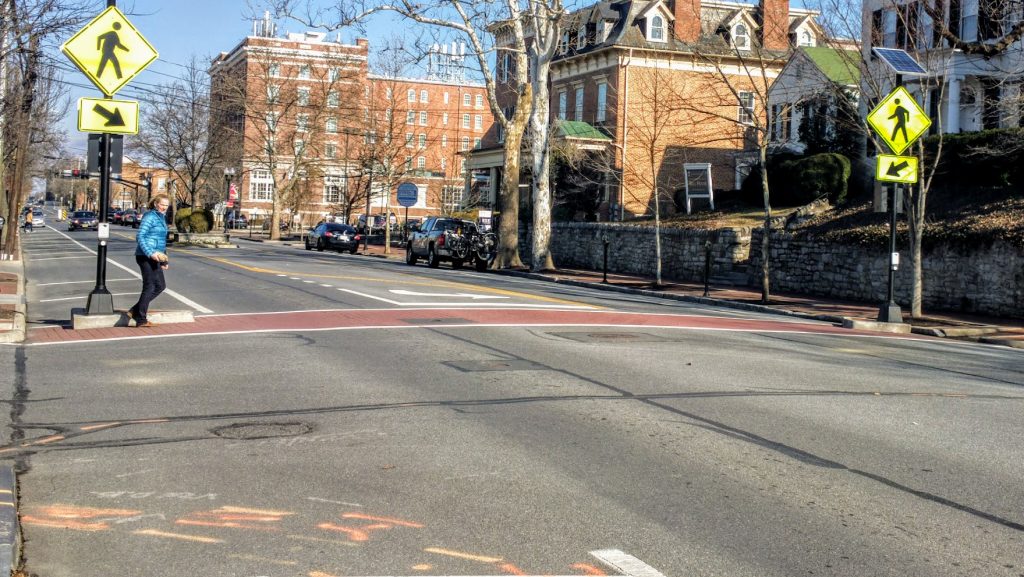By Kerry Irons, Pedal Holland
As people look for socially-distanced recreation close to home, the growing numbers of families and individuals out for walks or bike rides makes this a good time to review bicyclist and pedestrian traffic awareness.
The safety of active transportation users depends on traffic awareness by all involved.
Bicycle and pedestrian safety advocates often say that you should assume that drivers do not see you and take appropriate defensive actions. Some bicyclists go so far as to say (only partly joking) that cyclists should assume that they have a flashing light on their helmet that says “10 points.” A paranoid bicyclist in an urban setting can be excused for assuming that cars “are out to get them,” but that concern can promote greatly improved safety behavior by the rider.
A common complaint from some motorists is that bicyclists should be on the sidewalk because of their “dangerous behavior.” Yet, a recent study shows that bicyclists contributed to the cause of car/bicycle injury accidents only 2 percent of time by disobeying a stop sign or traffic light. Wearing dark clothing at night is a potential collision cause in about 2.5 percent of cases, and failure to use lights at night was mentioned 2 percent of the time.
Some motorists are not looking for cyclists, and cyclists are expecting motorists to see them when in fact the drivers don’t. Distracted driving (phone use, among other activities) only makes this problem worse.
Unfortunately, these same issues exist for pedestrians.
Sidewalk users need to be aware of motorist behavior and not just assume that the cars will yield appropriately. It does the pedestrian no good to be legally in the right but hit by a car.
Curb cuts have been a great benefit for disabled sidewalk users, but they tempt sidewalk bicyclists to blow through street crossings and can create a hazard if the bicyclists are not traffic aware. Pedestrians should try to establish eye contact with drivers before crossing the street.
All sidewalk users are considered pedestrians, even if they are riding a bike, in-line skating, using a power chair, or skate boarding. They must practice traffic awareness at intersections and crosswalks in anticipation that drivers are often not looking for them on the sidewalk. Simply entering the street because the pedestrian has the right of way can result in easily avoidable collisions.
Likewise, drivers being distracted by a phone or conversation can put pedestrians in danger.
Drivers need to scan the sidewalks on both sides of the street they are on and the street they are crossing to anticipate pedestrian behavior. A bicycle on the sidewalk can easily be traveling at 10 mph, so drivers need to “look ahead” and anticipate.
Just as pedestrians cannot assume that drivers see them, drivers cannot assume that pedestrians will behave correctly. And in both residential and business areas, where there are many parked cars on the sides of the street, drivers must assume that a pedestrian will sometimes decide to cross mid-block, emerging from between the cars. Drivers should look at the pedestrian’s face, which will often give clues about what they are going to do.
When road users and pedestrians make traffic awareness their first priority, everyone’s safety will improve dramatically.
Kerry Irons is a retired chemical engineer who has lived in Holland for five years. Irons is a lifelong cyclist who commuted to work by bike year-round for 30 years in central Michigan. He is a member of Pedal Holland, which advocates for bicycle safety in Holland.
This Week’s Sustainability Framework Theme
Transportation: The movement of people, goods and services within the area is an evolving system that links us to our regional, national and global networks.
ABOUT THIS SERIES
Living Sustainably is a collection of community voices sharing updates about local sustainability initiatives. It is presented by the Holland-Hope College Sustainability Institute, a joint project of Hope College, the City of Holland and Holland Board of Public Works. Go to www.hope.edu/sustainability-institute for more information.



